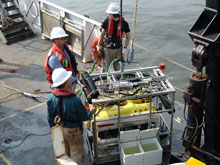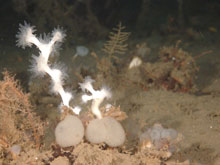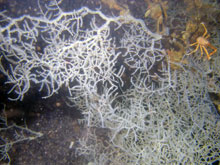Lophelia pertusa colony with polpys extended. Click image for larger view and image credit.
During the first dive of the cruise, scientists observed a large antipatharian (black) coral community. Click image for larger view and image credit.
Mission Summary
October 2, 2008
Erik Cordes
Lophelia II Chief Scientist
Assistant Professor
Temple University
We were out at sea for only two weeks, but during this time we explored many new areas of sea floor, made some very interesting discoveries, and collected a wealth of data that we will be working on for months and years to come. We collected multibeam data at 13 sites and completed ten lowerings of the remotely operated vehicle (ROV) at eight different sites. These dives yielded valuable data on the abundance of corals under different environmental conditions and geological settings.
At site GC140, we saw abundant gorgonian and antipatharian corals, but no scleractianians (including Lophelia pertusa). It is possible that the elevated temperature due to the shallow depths of this site prevented the deep-water scleractinians from colonizing the explored areas.
At the GB201 site, the seismic data indicated an abundance of hard substrate, but when we had the chance to observe the sea floor directly, the majority of the hard-grounds appeared to be covered by sediments. It is possible that the abundance of pockmarks seen on the multibeam bathymetry and seen on the bottom increased levels of local sedimentation, preventing coral recruitment and survival.
Multibeam data of the GC234 site revealed a long, linear ridge that was a continuation of the known coral ridge at the site. Exploration of this area revealed the presence of additional mounds and low-lying ridges colonized by L. pertusa, but the majority of the coral at this site was dead. We also collected a specimen of Paragorgia sp., the first occurrence of this genus in the Gulf of Mexico.
While exploring site MC751, we found a large area of carbonate outcrops colonized by living L. pertusa, as well as numerous species of gorgonians and antipatharians. This site exhibited fairly low relief, but was at the head of a small canyon-like feature that may channel sediment away from the area. This was the most impressive of the new corals sites we found.

The Saab SeaEye Falcon DR ROV allowed scientists to explore the deep ocean during the cruise. Click image for larger view and image credit.
The final dive at a previously unexplored area of VK906 revealed a long ridge system with gorgonian and antipatharian corals at the edge of a narrow canyon-like feature. At the southern portion of the site, the multibeam survey revealed a series of mounds. We explored one of these mounds at the very end of the dive and it appeared to be composed of a combination of dead L. pertusa skeleton and carbonate rubble. There were some live L. pertusa here as well, growing from the rubble on a fairly flat sea floor. This type of habitat for L. pertusa has not been observed previously in the Gulf of Mexico and should be another good target for future exploration and research.
Overall, this was a very successful reconnaissance cruise that explored a number of new sites in the Gulf of Mexico, discovering new areas of L. pertusa abundance and at least one new gorgonian occurrence for the Gulf of Mexico – a specimen that could turn out to be a new species. The cruise also gave many of the students on board their first experiences at sea and first sights of the deep sea. We will all have a lot to do to get through the specimens and data we collected on this trip, and we are already looking forward to our next chance to explore the corals of the deep Gulf of Mexico.
Sign up for the Ocean Explorer E-mail Update List.























